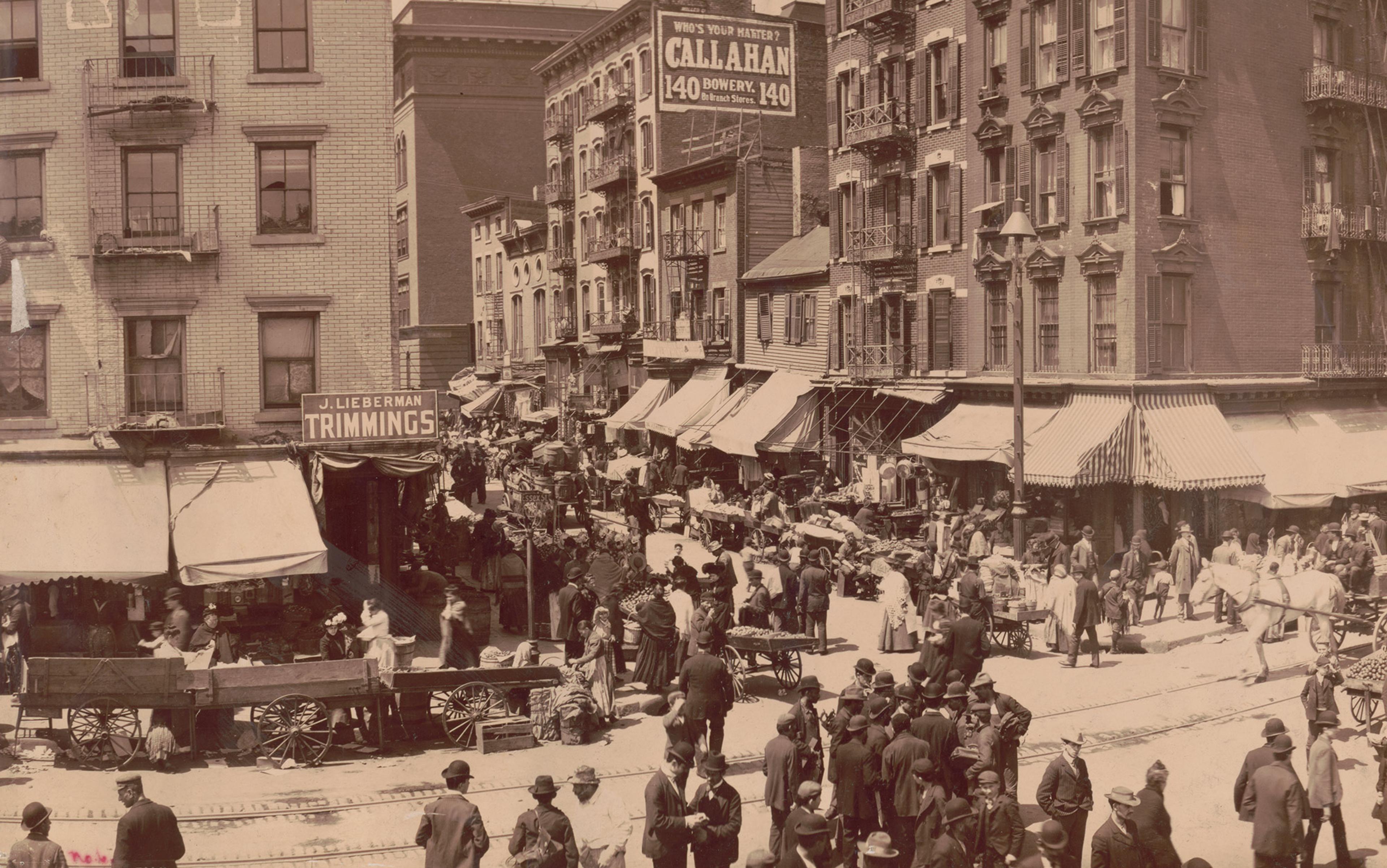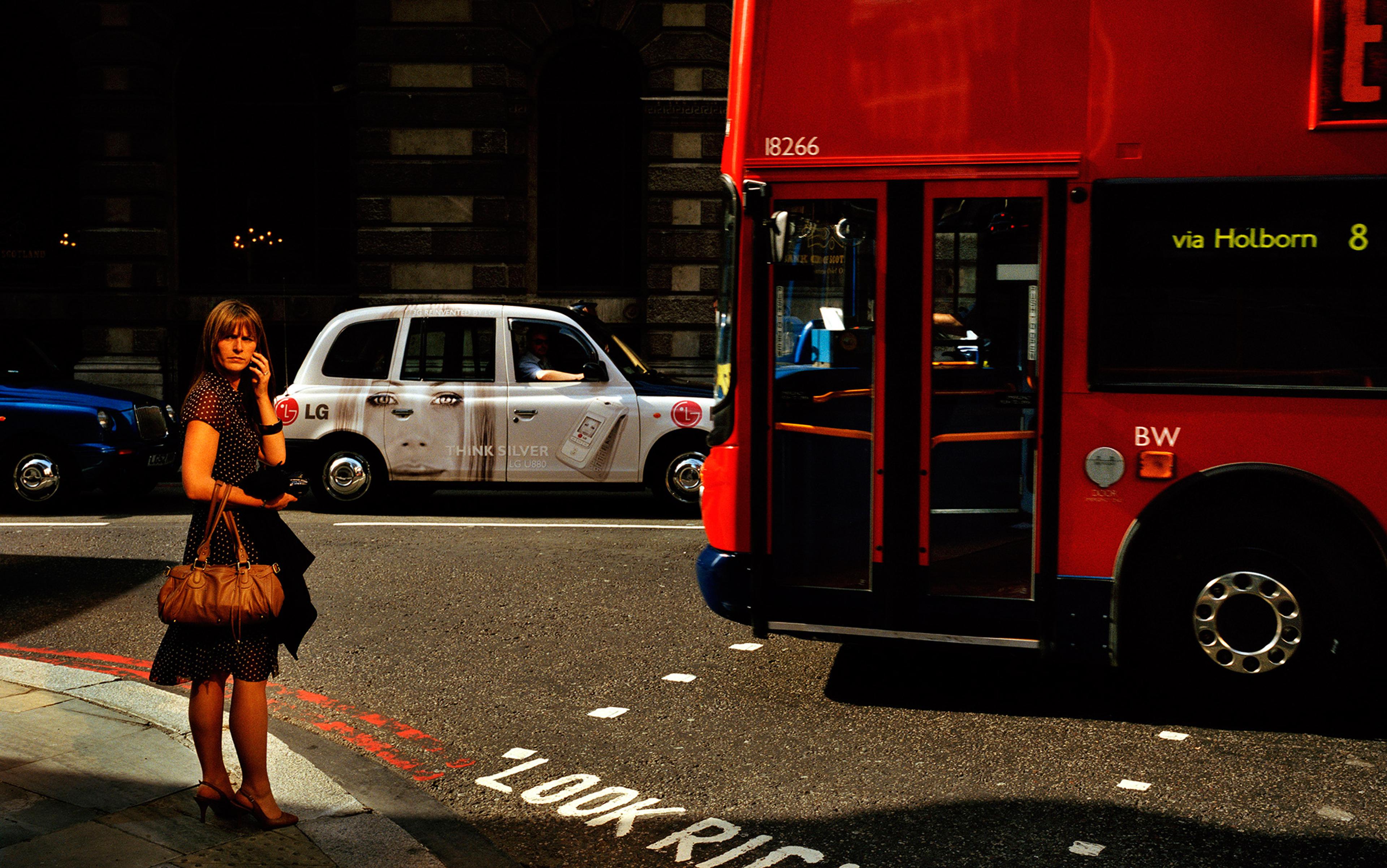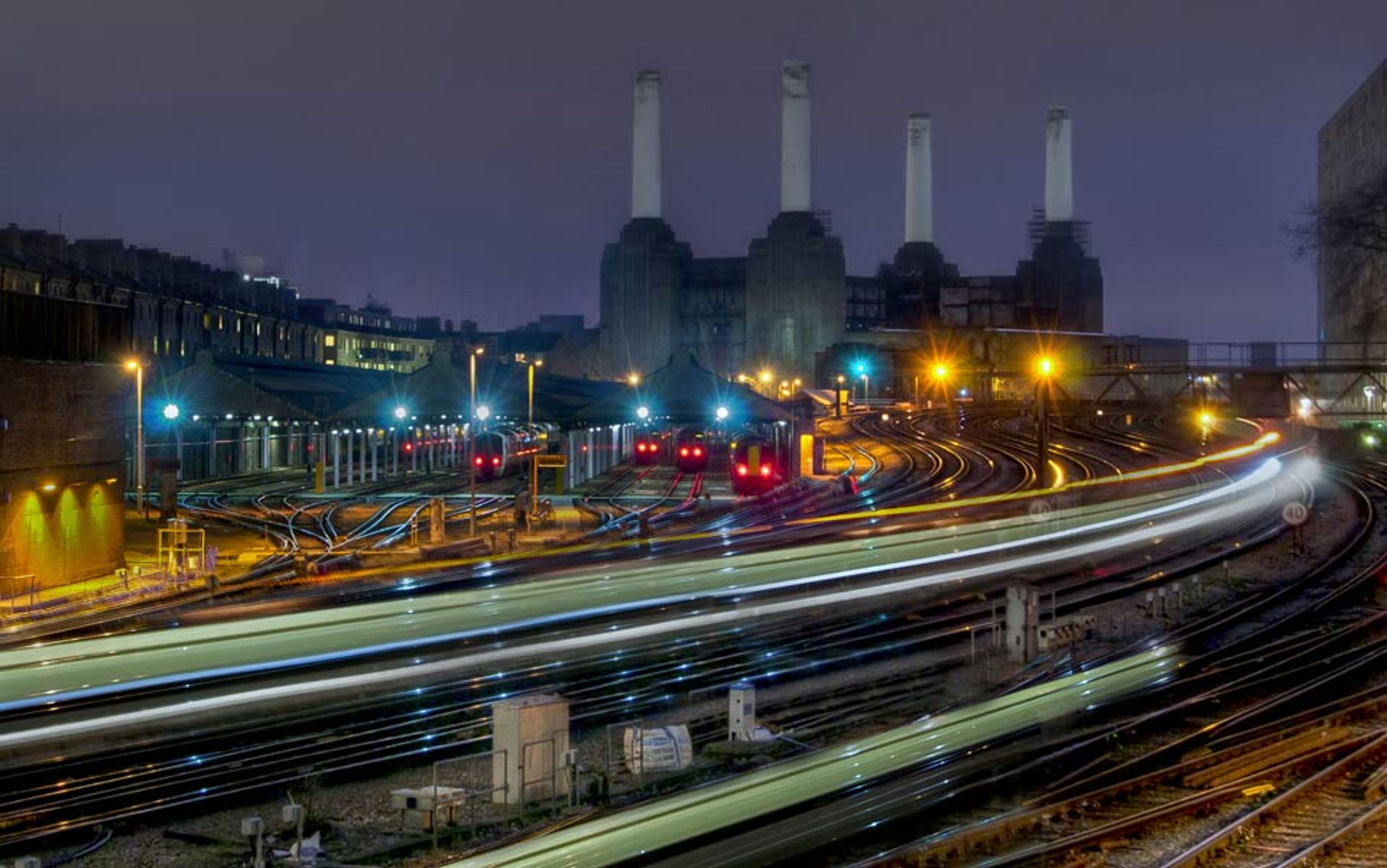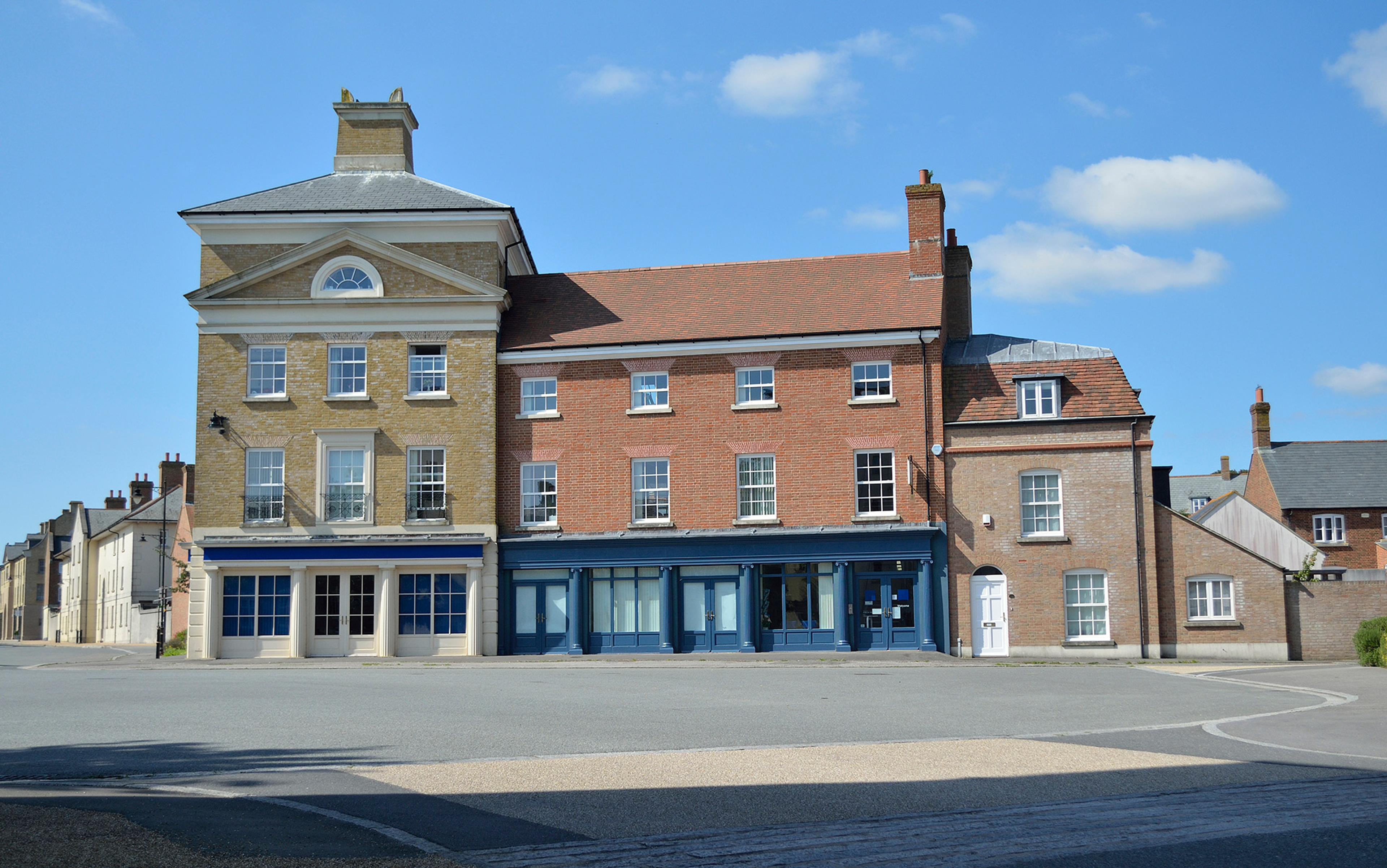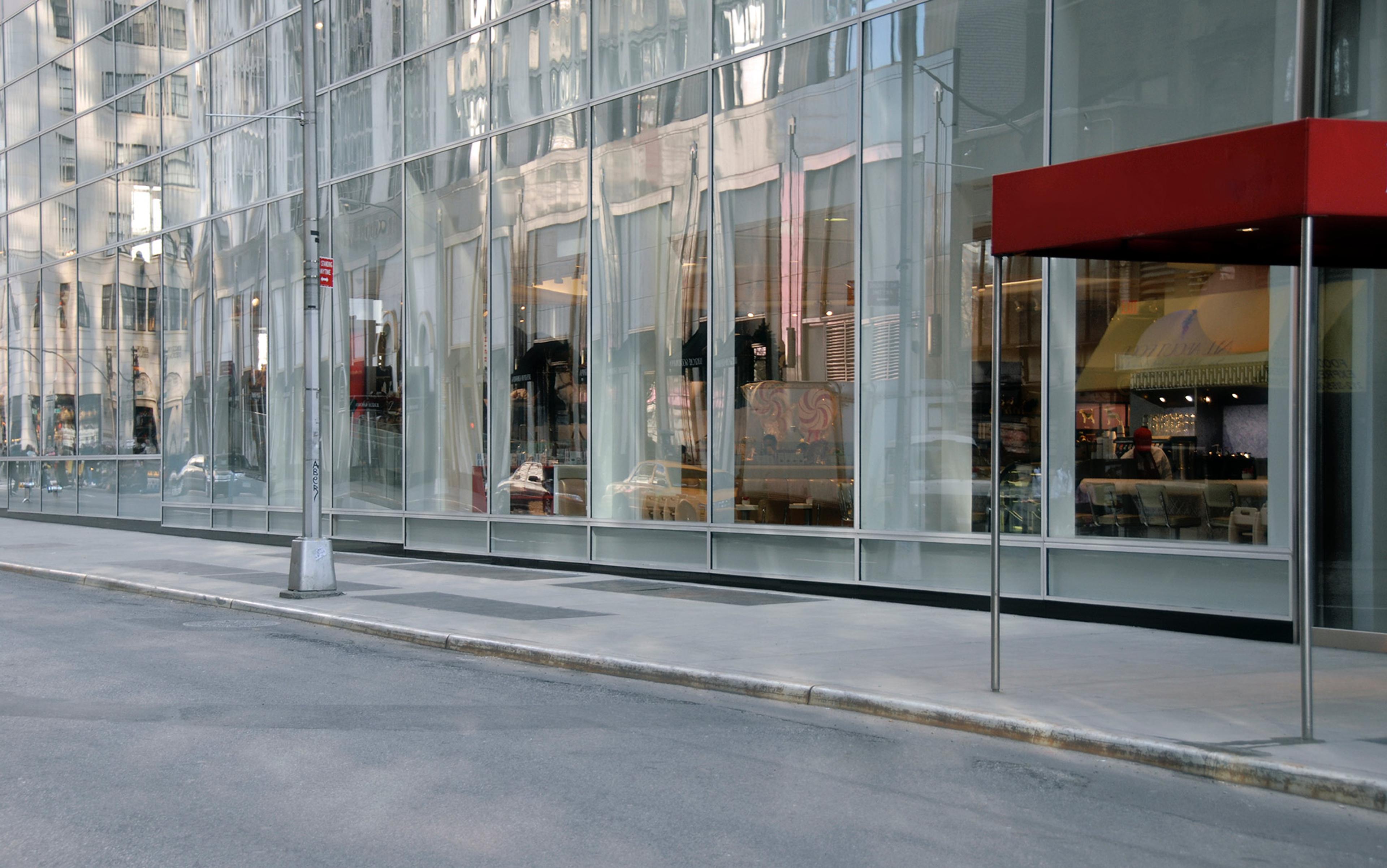The motorcar is one of the defining features of modernity. Society was transformed by the internal combustion engine and its utopian promises for society. Cars made distant places accessible for the first time, creating fast, long-distance personal transport that was never before thought possible. Like all technologies, this came at a cost. The biggest problems were for our cities, which had to contend with noise pollution, air pollution, and the loss of streets and neighbourhoods. The car shaped the form that cities – indeed societies – took in the 20th century.
Our relationship with cars tells us about society and its priorities. Traffic layouts last for decades. The size, configuration and busyness of roads all have an effect on the way we perceive cities. Cars and their paraphernalia determine where we walk, what we look at, and how much time and money we spend in a given place.
A different problem, though, is easily missed. Once these thousands of cars have got to their destination in densely packed cities, where do you put them? This, it turns out, was one of the big problems of urbanism in the 20th century. The problem was met with radically different answers in different places. And one of the more intriguing solutions is found in the strange history of underground parking.
Parking implies clutter in our streets, and the more central the parking, the more pollution the parking brings to heavily populated areas. Many of us have spent a great deal of time searching for a free spot in city centres, only to find nothing. It turns out there’s a name for this: it’s called ‘cruising’. This might seem a niche complaint, but research shows that as much as 15 per cent of urban traffic can be caused by cruising alone. The result is a measurable increase in carbon emissions and localised pollution.
Even if you do find a space, that space is at the expense of everyone else. Surface space for doing anything other than parking can be worth a lot more money, but we seldom realise it because we have lived with street and surface parking for decades. And this parking is often rented out much more cheaply than the market price, subsidising low-density neighbourhoods. Hence urban sprawl.
It didn’t have to be this way. Cars can be put somewhere else – still in city centres – yet out of sight, leaving parks, monuments and squares open. That ‘somewhere else’ was the oft-forgotten acreage beneath our feet. Although the idea is simple, it has been adopted inconsistently and was not always well-conceived. Quite literally overlooked, the story of underground parking has lessons for us all, teaching us to treat our towns and cities better.
One of the earliest underground car parks is in Pittsburgh, Pennsylvania, built in the 1920s
This story begins more than 160 years ago during the height of the Industrial Revolution. The depths beneath our cities have long been exploited for visionary infrastructure and the most impressive examples are the underground railways that were built in European cities from a remarkably early point. In this period, new urban neighbourhoods needed to be tied together by cheap mass transport. The problem was that buildings were in the way. Even for the railway companies, it was not feasible to purchase swathes of city blocks and displace residents to build their lines. The only remaining option was to tunnel beneath what was already there.
Solving the problem of land value and demolition, the underground tunnels were also highly logical: the clutter, noise and pollution could be kept out of sight, while the trains themselves didn’t need natural light, unlike offices and houses. The Metropolitan Underground Railway, which later became the London Underground, took the initiative in the 1860s. Then the bold idea rapidly caught on in the later 19th century, in Liverpool, Budapest, Paris and beyond.
It would be some decades before the motorcar would shake up transport again, at the turn of the 20th century. But the movement to put railways beneath streets provided a clear precedent once cars were popular. The two situations are similar: a vital but ugly piece of infrastructure becomes hungry for space where it is at its most expensive. Underground parking for cars is nearly as old as cars themselves. One of the earliest underground car parks is in Pittsburgh, Pennsylvania, built in the 1920s. Britain had some pioneering structures too, such as the art deco car park on the Hastings seafront, built between 1925 and 1939.
Though Britain and the United States may have been precocious with putting car parks underground, these early experiments weren’t implemented at scale. Once the motorcar was ubiquitous and there were many more vehicles to deal with, cheaper but much less elegant solutions took over in the English-speaking world, for reasons we’ll explore in depth below. It wasn’t in the Anglosphere that underground car parks came into their own, but in continental Europe. That rift between two different parts of the capitalist, democratic world invites the simple question: ‘Why?’ To understand this, we have to start by looking at the middle of the 20th century when cars became the new norm.
In the early days of the motorcar, the vehicles were very expensive. It took a wave of wealth after the devastation of the Second World War to make them popular. By the 1950s, average household incomes grew in most of western Europe, with families and individuals suddenly becoming rich enough to own a motorcar. An explosion in private transport quickly followed. Machines as well as nature abhor a vacuum, and automobiles flooded the biggest public spaces available. Prestigious town squares were soon packed with cars.
The problem of urban space and the motorcar soon became apparent, and the need to do something about it became urgent. Where cars piled up ad hoc in European city centres, the US imposed more radical interventions early on. Downtown areas of the major US cities were, with few exceptions, thinned out to provide freeways and massive parking plots. Although the demolitions weren’t nearly as extensive, the UK is similar to the US in that very little underground parking was built.
In continental Europe, this kind of car-centric demolition didn’t happen. Europe’s much older historic city centres were kept intact (as far as they could be after the Second World War, though in some cases they were reconstructed). There was less appetite for reorganising the city, and less money than in the US. In many cases this meant public squares that had previously been reserved for people were filled with cars.
It’s now famous for its bikeability, but the Netherlands in the 1960s was no exception to the problems. Maastricht, one of the country’s historic university cities, forms a good case study of how the European and Anglosphere approaches differed. By mid-century, Maastricht’s residents complained bitterly that the city’s central square, the Vrijthof,
has become an open-air garage, with clouds of dust in the summer, with puddles and mud when it rains. A pedestrian cannot walk, children cannot play there … the most beautiful square in the Netherlands … is a huge disappointment.
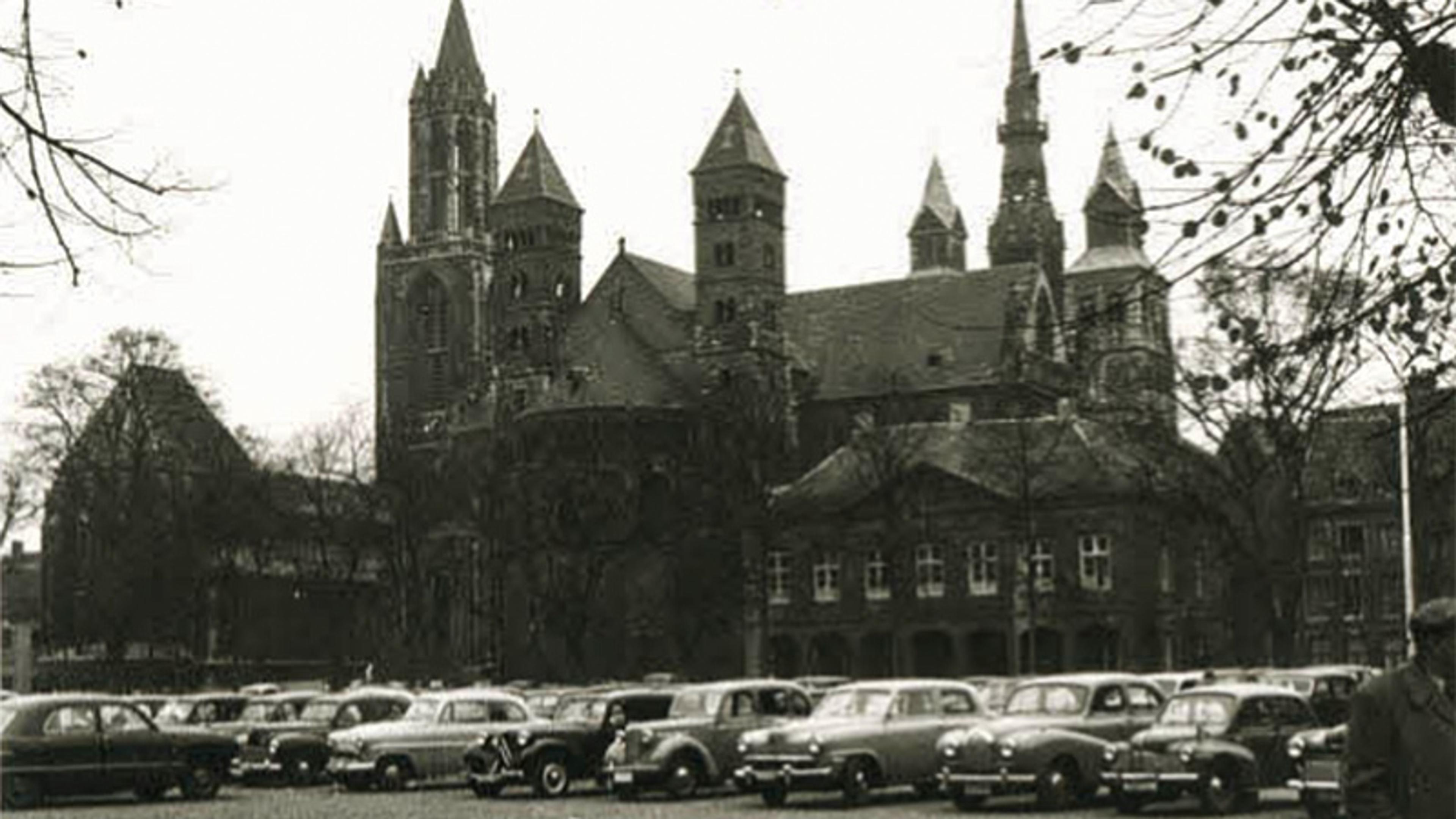
Vrijthof in Maastricht, Netherlands in 1953. Courtesy Regional Historic Centrum, Limburg
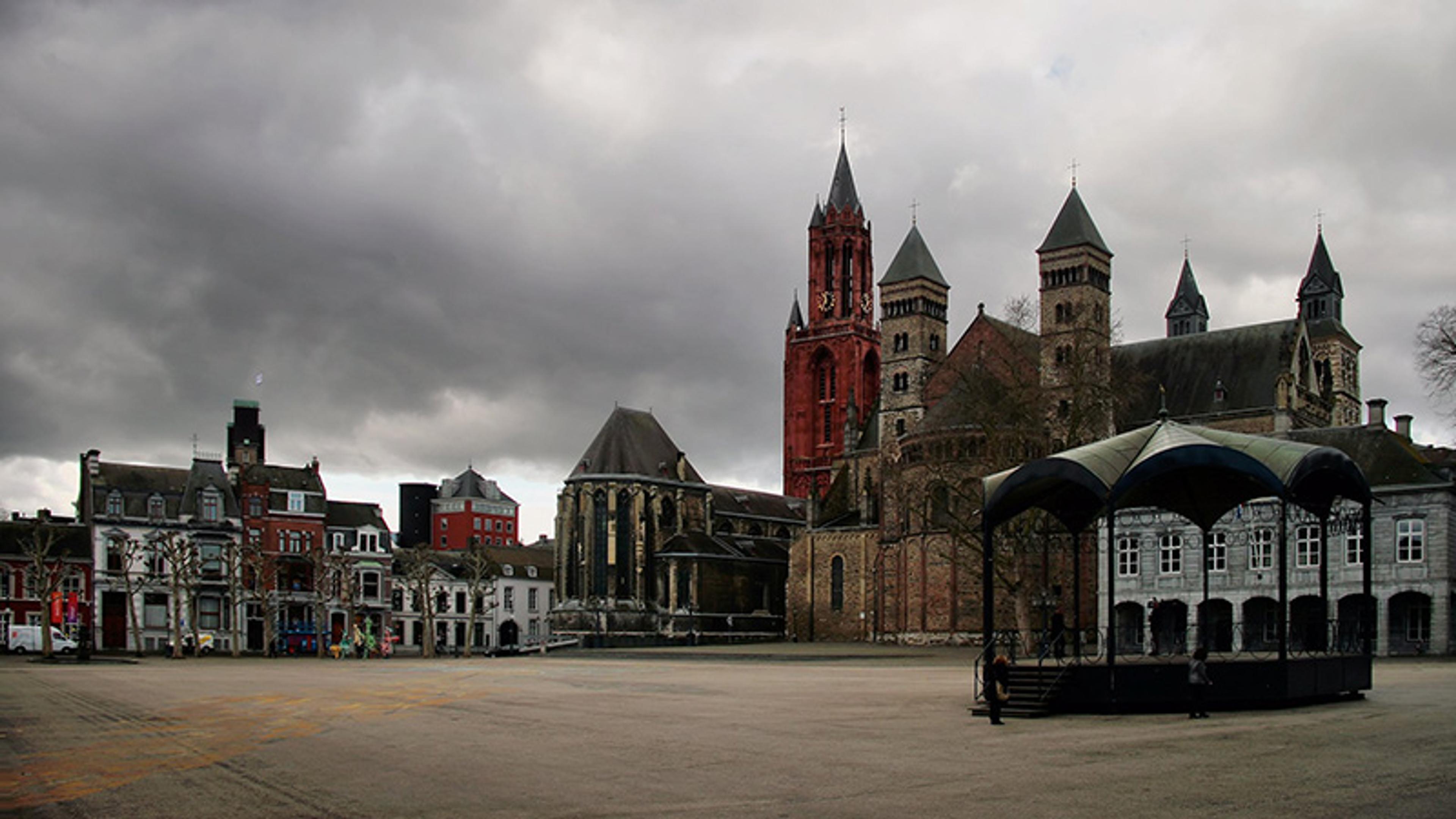
ijthof in Maastricht in 2015. Courtesy Jorge Franganillo/Flickr
Maastricht’s municipality searched for a solution. Their idea was simple: dig up the central square and put parking beneath it. They began planning in 1967, while archaeological investigations paused the four-year project for six months. Although it was slow, the project would have been far slower with a more complex site. Barring its archaeological value, a public square is as close to a blank canvas as a historic city-centre site can be – the temptation for such spaces to turn into garages was also a blessing in that they could more easily be excavated.
The excavation of an underground car park is generally done through ‘cut and cover’, the simplest type of underground construction. One digs downwards in a giant trench, usually with supporting ‘piles’ which define the edges of the building, and which stop soil from backfilling the site. To build an underground car park, therefore, one has to have a clear area. This either requires demolition of existing buildings, or a space which is already free – such as a ground-level car park or somewhere cleared by Second World War bombing.
It was designed to accommodate driving in a way that didn’t ruin what made the city pleasant in the first place
An important piece of context for the Maastricht project, and for any other underground car park, is that they are expensive to build. A 2010 estimate of construction costs for underground parking put the cost per space for above-ground multistoreys at €15,000-20,000, while the equivalent underground space would be €40,000. The reason for this expense is the complexity and uncertainty of the underground environment: logistics, soil stability, cutting into bedrock, water ingress, changes to the water table, subsidence in nearby structures, and of course, archaeology.
In Maastricht, the open Vrijthof square was the obvious location for a car park. But the municipality had to find the money to build it. They decided to hand the risk of the expensive construction project over to a private property developer. Both parties were aware that the project could result in losses, at least in the short term, because of its scale and the unknowns of building underground. The total cost was considerable, totalling 6.5 million guilders (about €14.3 million in 2020).
The project was not designed to prevent driving, or even discourage it, but to accommodate it in a way that did not ruin what had made the city pleasant in the first place. The Vrijthof garage was completed in 1971 and opened with 445 spaces – compared with the 281 that were able to park in the square. The cars were gone, stowed away underground. And once they had been cleared, they did not return: the Vrijthof remains a public space, with various open-air events including a Christmas market that has run since 2000.
Maastricht isn’t alone in the Netherlands for being replete with underground garages. Counting only fully underground facilities, the areas include Amsterdam (nine underground garages in the old city centre, a square mile), Rotterdam (16 run by the municipality alone, plus private garages), The Hague (10; its largest underground/underwater parking facility has an impressive 1,400 spaces), Eindhoven (six) and Groningen (seven). An exception to this is Utrecht, whose historic city centre is a minuscule half a mile across, and its medieval street plan lacks open space for excavation.
The Netherlands was typical of Europe in general. Excavation to create parking out of otherwise blighted public squares was done throughout continental Europe between 1960 and 1980. Maastricht shows what it took to build an underground car park in Europe: public funds, public space and public motivation. Added to these factors was precious heritage, often legally protected, and perhaps a cultural resistance to radical ‘traffic modernism’. Le Corbusier’s rebuilding of Paris, after all, was never more than a pipe dream.
This contrasts dramatically with the approach in the UK and US. In both countries, the underground car park was sidelined in favour of other solutions. The reasons have to do with the peculiarities of each country, particularly with their political structures as well as their cultural outlooks in the mid-20th century.
In the UK, parking regimes were dealt with at the discretion of local councils, who were given powers to construct off-street parking if they wished. There was never a preference for underground parking enshrined in policy, let alone a specific target for, say, a certain number of underground parking spaces in the capital, as was the case in France.
The result is that underground parking is very rare in the UK. Bristol, for example, has zero underground car parks in its old city centre, while the similarly sized Nuremberg has three within its fortified city walls alone (an area of only 1.5 square kilometres). Instead of underground car parks, Bristol has a sequence of enormous above-ground car parks on multiple stories in its old city centre.
The exceptions to underground parking in Britain are telling, reserved for the best-resourced institutions on the most expensive land. One of the most important was built on the southern side of Hyde Park in central London. That necessitated an act of parliament, the Hyde Park (Underground Parking) Act of 1961, yet all this did was authorise the use of royal estate land for the purpose. This idea was not part of a premeditated policy, but an ad hoc reaction to parking difficulties in one part of London. As the member of parliament Ernest Marples said in a speech to the House of Commons:
Mayfair, of course, is an extremely difficult place in which to provide off-street parking, because of the expensiveness of sites. That is where Hyde Park comes in as really a godsend to the Government.
The Commons proceedings about the Hyde Park project indicate the lack of familiarity with the idea of underground parking in the postwar motorcar boom. One minister, Gilbert Mitchison, asked ‘is there any precedent for constructing an underground car park?’ Marples could think only of the car park in Finsbury Square, constructed between 1959 and 1961, as an example. But there were other European precedents: by the mid-1950s, the cities of Bern and Lausanne (both in Switzerland) had underground car parks, along with Rouen in France (1951, built at a staggering cost of £320 million adjusted for inflation).
The main hurdle for underground parking is the initial expense
Marples was Minister of Transport and oversaw most of the Beeching cuts which aimed to slash the UK’s rail network to a fraction of its size. He was a fan of the automobile. However, his government’s support of cars stopped short of providing the kind of centralised plan for parking across the country that was so marked in the European approach. Hyde Park’s underground facility was funded in its entirety by a developer, who then received all of the revenue from its operation. More broadly, the government left the planning, construction and finances of public parking projects down to local authorities. In the Commons debate, Marples stated that:
Although the Government have firmly decided against giving aid from central funds for the provision of off-street parking, we do wish to help in any way we can, apart from a direct monetary grant. In the Road Traffic and Roads Improvement Act we included provisions to make it easier for local authorities to provide garages, and also to make possible maximum development by allowing, for instance, shops to be combined with garages.
Sections 13 to 14 of the Road Traffic and Roads Improvement Act (1960) indeed gave authorities the right to create off-street car parks, and to charge fees for parking in those places. It also gave local authorities the ability to get private companies to run parking garages in return for a lump sum. What the act did not do is provide any special incentives or funding to build such structures or determine how they would be designed. The result was a scattering of different projects, with different funding models. Crucially, local authorities have less bargaining power than the central state, or even than a large municipality, and of course, less cash. The main hurdle for underground parking is the initial expense, which proved too much for most public authorities in England in the absence of a state subsidy.
Occasionally, local incentives and resources would be strong enough to force the development of an underground car park. A symbolic case was at the Palace of Westminster. In the early 1960s, when MPs began to drive to work in large numbers, they simply parked in Old and New Palace Yards. These are formally public squares that sit between the buildings of the Palace of Westminster (which contain the Houses of Parliament). It was an increasingly cramped and unsightly arrangement.
In the continental fashion, Parliament resolved to dig beneath the New Palace Yard. Owing to the yard’s relatively small proportions, and the precious buildings surrounding it, the project expanded downwards. It was to be five storeys deep, accommodating 450 cars, and was completed in 1974. In the end, those 450 spaces cost the equivalent of £23 million, or £52,000 per parking space. As the MP Nigel Spearing put it, this was ‘slightly expensive’. That expense was not borne by the local authority budget but quietly from the public (ie, national) purse.
Parliament got its way, but it is difficult to imagine a local authority carrying this off. This project remains an exception that proves the rule in the UK, of limited local resources leading to poor quality, above-ground parking rather than the much better but more expensive underground solution. In the US, the picture is even worse.
The US love affair with the motorcar is long and spirited. The country was far richer far earlier than Europe. The massive aircraft-building capacity in the US switched after the Second World War to the production of private cars. Dwight Eisenhower’s postwar Interstate Highway System created an unprecedented high-speed road network, adding to the demand for cars. We might expect infrastructure to match the world-beating car ownership rates, including underground parking. This wasn’t the case: underground parking is rare in the US. Why?
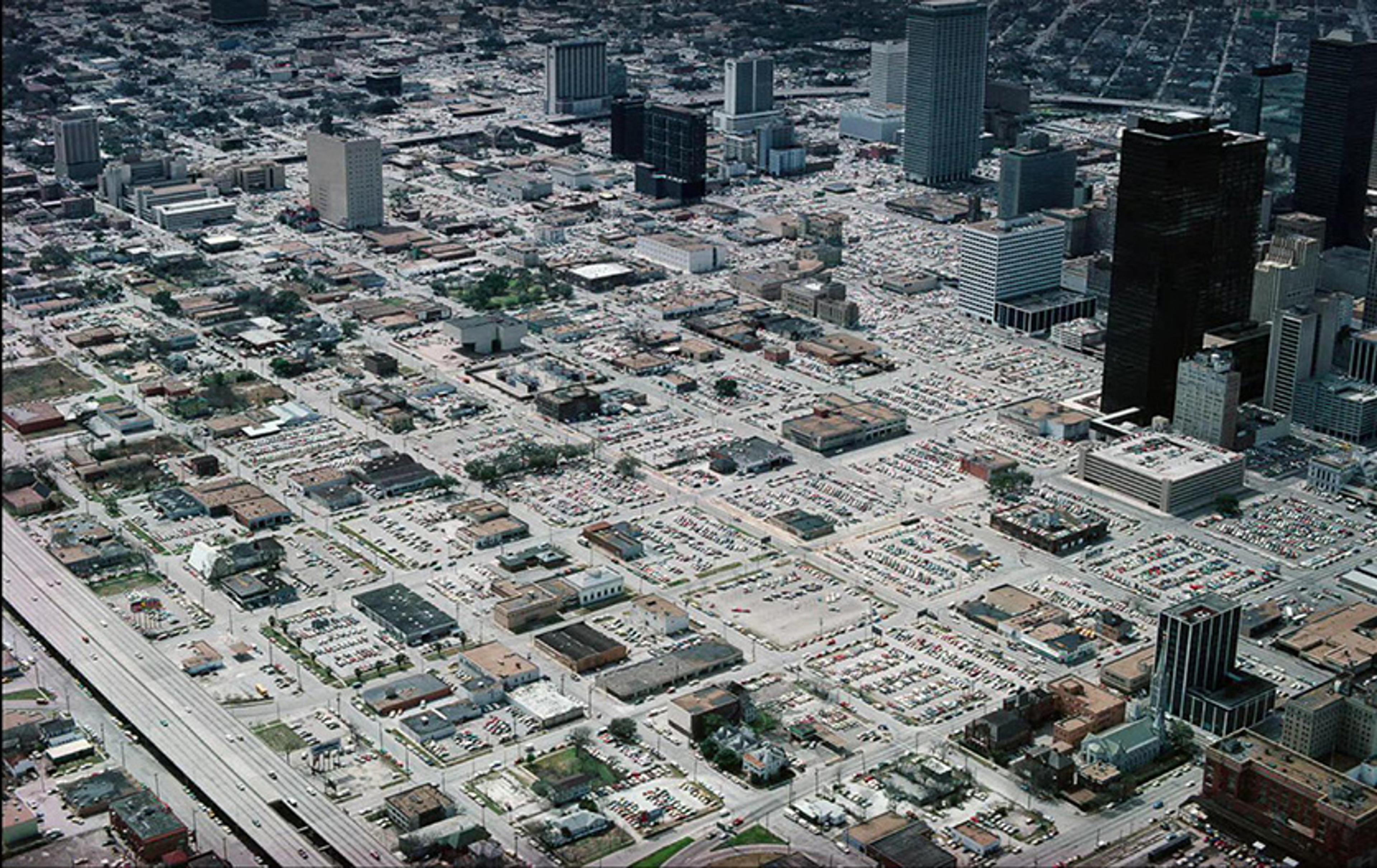
Houston, Texas, c1970. Courtesy Reddit
To begin with, we need to look at where all the cars ended up. In US cities, cars take up open-air lots – over staggeringly large areas of land. Research in 2023 revealed that 49 per cent of the city centre of San Bernadino is given over to parking lots. In Wichita, it’s 35 per cent; in Las Vegas, it’s 32 per cent. Take a city such as New York that approaches the density and land values of some European cities, and you find that the percentage of land for parking is only 1 per cent. But in a city where it’s affordable to have more than a third or nearly half of central land allocated for parking, it makes no economic sense to start digging car parks beneath the streets. And, if you have so much parking anyway, there’s no need.
Actively thinning out city centres and replacing them with open parking lots almost never occurred in the Old World
All this abundant, centrally located open-air parking in the US didn’t appear by magic. A mixture of choices made this happen, some of them stark and some of them subtle. In many cities, municipalities simply demolished large tracts of ‘undesirable’ neighbourhoods for parking and roads. What this really meant was displacing large and historic Black, Hispanic, Asian, and other minority communities into low-quality housing projects, a process documented by the Segregation by Design project. Cities’ zoning laws often permitted only low-density suburbia to be built, creating cities that sprawled rather than stacked. This gave developers the space to put parking above ground and indeed gave them rules to forbid them from doing anything else.
Demolition in city centres and equivalents of low-density zoning did happen in places outside the US, but the vigour of this approach was not replicated in Europe. Actively thinning out city centres and replacing them with open parking lots almost never occurred in the Old World. There are a few examples where historic cities were damaged substantially enough for new roads but not parking, like in Norwich, England, while there were plenty of failed projects like the ‘ringways’ of London or Le Corbusier’s Plan Voisin for Paris. These failed because of resistance, both from public action groups and from the authorities themselves, but probably also because these war-bruised nations were too poor to do anything on the scale of Eisenhower’s Interstate project and its related schemes.
The flipside of this is what happened with underground parking. Where European nations were too resistant to the radicalism of ‘traffic modernism’, the ‘invisible’ solution of paying to put cars beneath streets seemed a worthwhile tradeoff. A cultural norm of high municipal spending enabled the hurdle of expense to be jumped over fairly easily, especially if deals could be made with private enterprise further down the line. Postwar policy explains the great disparity in the concrete-and-car dominance of American streetscapes and the discreteness of those in Europe. The decision in the UK to rule out subsidies or other incentives for parking explains why it followed a path more like that in the US than its closer neighbours.
We shouldn’t take a rose-tinted view of the European approach, though. The rationale behind underground parking was not always sound, and sometimes looked rather like a mad rush for motor infrastructure at the expense of all else.
Underground parking often did not pay for itself. The expensive buildings became too difficult to fund, even in maintenance costs. Too few were using the underground car parks. Although the Vrijthof car park in Maastricht worked wonders in removing the ‘carbage’ from their best town square, the car park itself suffered by the 1980s, and became known for its danger and disrepair. The reason was simple: the car park was not drawing enough revenue and the operator was not reinvesting in the structure.
On-street parking was still far too cheap in comparison with off-street parking. The Anglosphere’s scepticism of the lavish approach to parking was at least partly right: they could easily cause a loss for authorities or companies that took them on when other things weren’t in place. If on-street parking was more convenient and cheaper, drivers wouldn’t bother to use them, in turn failing to pay for the investment. To make this work, a completely different way of thinking about parking was needed than the 1960s model of meeting ever-expanding demand.
The pricing of different parking choices is critical: this is how the projects can pay for themselves
Underground parking is still being built in Europe, but with a new theory behind it. Subterranean parking is now conceived as one part of urban master planning and sustainable transport design. Pricing structures, rival transport schemes, and the beautification of the city are all being considered at the same time. One doesn’t simply build underground parking because we need more space to put the cars, but rather because we make an active choice to free up our streets.
Strasbourg in France is a perfect example of this change. Between the early 1990s and the present, the city has undertaken a coordinated push to relocate cars off the street and into purpose-built, underground parking. This has been done not just by building below-ground parking, but by reviewing the pricing of on-street parking, replacing some on-street parking with bicycle spaces, and creating a new tram network which serves the very centre of the city.
Amsterdam, Copenhagen, Paris and Antwerp all use underground parking, and on-street parking is prioritised through pricing, time limits, or otherwise reserved for residents. The pricing of different parking choices is critical: this is how the projects can pay for themselves. This holistic process has been described aptly as a move from ‘accommodation’ – as much parking as possible – to ‘regulation’: parking supply which is intelligently designed to fit with the needs of the city and its people. Underground parking is not a panacea. But it is an elegant and important tool, among others, that we should use to make our cities work for us all.
As cities evolve, so must their infrastructure. If the use of cars does decline in the future (and we would see this first in major cities), one might wonder what to do with underground parking. Underground parking garages are essentially large warehouses capable of withstanding significant loads, with ramps for access, and a stable ambient environment. In Paris, they’ve been retrofitted into mushroom farms; in London, they’ve become video art galleries. The underground car park is not just a solution to a current problem, but a thoroughly sensible use of space for future generations.

